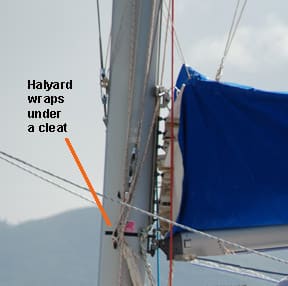Sails – Getting Familiar with a Charter Boat

Modern charter sailing vessels are equipped with a roller-furling jib or genoa and often a roller-furling mainsail. These sails make deploying and stowing the sail much easier than hoisting and hauling down hanked-on sails. Roller furling systems allow us to deploy the sail by releasing the in-haul furling line from its clutch and pulling the sail out with the appropriate jib sheet for the jib or main out-haul for the main. When the sailing is over, roll the jib/genoa sail in by removing the jib sheet from the winch, and maintain slight tension while the jib furling line is hauled in. The sail should furl tightly around the forestay foil mechanism. Continue furling until the jib sheet wraps twice around the forestay, and then close the line clutch on the furling line, and stow the sheets.
| Caution: The jib sheets when loosened will whip wildly and dangerously. First, ensure no crew are on the foredeck and secondly keep enough tension on the jib sheet to reduce the whipping. |

Traditional mainsails are rigged on about 60-70% of most charter boats and are most commonly flaked along the boom when not in use. Lazy Jacks are lines extending from about 1/3rd or 1/2 way up the mast down to various positions along the boom. These are a great invention. They automatically envelop the sail side to side as it comes down into a Stac-Pac. This is a giant sail cover already positioned on top of the boom. This makes lowering the mainsail quite simple. With the boat pointing in an upwind direction and two wraps of the halyard around the winch just release the halyard clutch and let the mainsail lower into the Stac-Pac. Here’s a trick that we always do for safety. With a sudden and unexpected high wind, the sail can be blown out of the Stac-Pac. This is potentially dangerous and could pull you off the anchorage etc. To prevent this you can either zip up the stac pac to prevent the sail from deploying (this is difficult and time-consuming) or you can reach up and grab the halyard close to the head of the sail and then pull it down to wrap under the halyard winch or a mast mounted cleat then close the halyard clutch and tighten the halyard. This serves to pull the sail down and lock it down.
To hoist the traditional main sail, first, open the Stac-Pac or unhook the halyard from the winch (as above). Now remember how I said lazy jacks are a great invention? This is where you might have a sailor’s mouth. Lazy Jacks always snag the battens at the leech of the sail. Always – every time – without fail! So don’t just keep winching the halyard up, the lazy jacks ARE going to snag. A couple of tricks we’ve learned here. Have a good helmsman to steer the boat constantly and accurately into the wind. Have one person hoisting the sail while keeping a watch on the lazy jacks and battens and have one more person maneuvering the boom to port or starboard to prevent the snagging and at the same time calling to the hoister to go up or let down. This problem is especially prevalent in catamarans. If you have lazy jacks on your own boat, attach bungee cords from the spreaders to the lazy jacks. This tends to pull the lazy jacks out wider and reduce the chance of snagging.
One more thing that tends to get snagged on the way up is the reefing lines. Inside the boom at the front of the boom are clutches that grab the reefing lines. Ensure that these don’t lock as you hoist the main.
|
Anecdote |
The topping lift should not support the main sail after it is hoisted, but it must be tight enough to support the boom as the sail goes up. (Reminder – the topping lift is the line from the back of the boom to the top of the mast. It holds the boom up when the sail is stowed).
Determine whether the main sail should be reefed before it is deployed. Reefing is most easily done before raising the sail. Reefing lines on charter boats are typically colored and already set up. Most commonly you’ll pull in the appropriate reefing line and lock it with the clutch inside the front of the boom. This acts to pull down the leech (trailing edge) of the sail to the boom. Then simply hoist the main halyard as normal. (Watch out for those batten-catching lazy jacks).
The sail is hoisted according to wind conditions and the intended point of sail; more luff tension when sailing upwind (close-hauled or close reaching) or with higher wind strengths and less luff tension in light airs or sailing downwind. A convenient gauge is to look for either vertical ripples in the sail (too much halyard tension) or horizontal ripples in the sail (insufficient luff tension) along the luff area of the sail. See NauticEd Sail Trim clinic.
Once the sail is hoisted, be sure the line clutch is closed, coil the remaining halyard into a neat roll, and stow it out of the way. The main sheet is now tensioned appropriately, the sail is adjusted along the traveler, and the sheet is tweaked for optimum sailing efficiency.
|
A final safety trick to share in this department. As you know – sailing downwind has the dangerous potential of the accidental gybe. This can be quite a common occurrence if you have an inexperienced crew at the helm or perhaps with a major wind shift when sailing close to an island and … well… with the added distractions of vacation, an accidental gybe is probably going to happen. Please teach your crew to only walk to the front of the boat on the boom side of the boat when sailing downwind. In this manner, the boom is only traveling at a bruising 20 miles per hour when slamming across instead of the fatal 100 miles per hour when it reaches the other side. |







